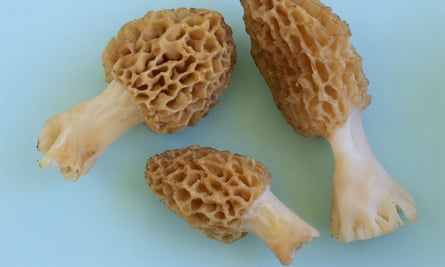Foragers in the US have begun checking maps outlining where the wildfires of 2015 scorched the Pacific north-west in the search for one thing: morel mushrooms.
“It’s going to be a good season for finding morel mushrooms, there’s no doubt about that,” said Brian Harris, spokesman for the Payette national forest in Idaho.
The spongey-looking, woody-tasting delicacies have defied commercial cultivation and can retail for $20 a pound (£14 for 450g).
“They’ve got a kind of cult following,” said Tommy West, a produce manager at the Co-op in the Iadho city of Boise. “When they do come into season they usually move pretty good.”
Nearly a million acres (400,000 hectares) of US Forest Service land burned in 2015 in Idaho, Oregon and Washington, the National Interagency Fire Center said. Maps of specific wildfire perimeters are available online at the Forest Service’s InciWeb.

In the Payette national forest, harvesters who want the mushrooms for personal use can gather up to five gallons a day without a permit. A 21-day commercial permit from the US Forest Service allowing more than that costs $200.
While the tastiness of morels is well understood, the difficulty of studying them in the wild makes them something of a mystery and pinpointing where they might appear difficult.
Mushroom spores can spread over an area by the millions. The spores germinate and create delicate underground growths that look like spider webs. The growths eventually include nutrient storage areas. Experts say these formations, called sclerotia, can exist for years, but the fruiting bodies desired by mushroom pickers appear only when conditions are right, and that might not be for decades.
“After a moderate fire moves through an area these ‘ready to go’ sclerotia form fruiting bodies referred to as post-fire morels,” said Merlin White, a Boise State University assistant professor. “Post-fire morels commonly start fruiting a few weeks after a fire and continue to fruit for about two years before seemingly disappearing from the landscape.”
Prime picking areas can be hard to identify even with a good understanding of morel reproduction. Some scouting could pay off, especially if a small flower called the western white trillium is spotted, an early indicator morels might pop up, Harris said. “It’s kind of a telltale sign,” Harris said.
In 2015, the Payette national forest had one of Idaho’s largest wildfires when the Tepee Springs fire burned 150 square miles (390 sq km). Getting away from roads and hiking into the forest is a good strategy to find more mushrooms, Harris said. Also, don’t procrastinate.
“If you wait too long and the commercial pickers move through the area before you get there, you’re not going to find any,” Harris said.
Another problem mushroom hunters sometimes confront is getting caught up in the thrill of the hunt, resulting in the need for searches by local authorities.
“You can get so absorbed in what you’re doing that you can lose track of where you’re at, lose track of time, and the next thing, you can look up and go, ‘OK, where’s the car?’,” said Nora Rasure, who oversees the intermountain region as part of the forest service.

Comments (…)
Sign in or create your Guardian account to join the discussion